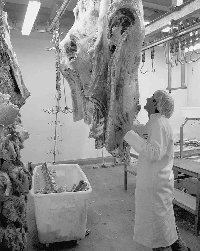Another Market Gives Up to the Foreigners Ukrainian cattle go for barter

The Ministry of Agro-Industrial Complex (MAIC) intends to seek preferential terms for meat imports. According to Volodymyr Popov, the Director of the MAIC Department for the Meat Processing Industry, meat processing plants suffer from an oversupply of imported sausage, lack of working capital and, most of all, shortages of raw meat.
If the Ministry succeeds, the imported meat will be processed by enterprises authorized by the government, similar to the preferential scheme used for importing raw sugar and vegetable oil.
Currently, Ukraine’s 140 large meat processing plants are working at only one-third of capacity (1.2 million tons a year). Their output has fallen substantially compared to last year. In the first quarter, they processed only half as much meat and meat products than in the corresponding period of 1997, one-third less sausage, and almost two times less semifinished products and canned meat.
Yuri Melnyk, the Director of the MAIC Cattle Department told The Day that sales volumes of slaughter cattle continue to fall: from January to April they dropped by 20% compared to the previous period (and by 63% in specialized farms).
According to the experts, cattle are being used in barter operations to buy fuel for field work (at an exchange rate of about 2.5 tons of meat per ton of diesel fuel). Product supplies by cattle farms to meat processing plants were halved. MAIC specialists say they have little doubt that the meat supply will increase in the near future, because processing enterprises lack working capital and have not been paid for products sold earlier. But the main problem is that making contracts with meat processing plants is just not profitable for cattle farmers who think that the purchase price is low.
The average purchase price set by Ukrainian meat processing plants is Hr 1,450 a ton (vs. Hr 929 last year). The lowest purchase prices were recorded in Volyn (Hr 1,160 a ton) and Chernihiv (Hr 1,230) oblasts, the highest in Dnipropetrovsk (Hr 2,430) and the Crimea (Hr 1,790). Most probably, the high purchase prices for cattle are explained by Ukraine’s lowest sale volumes of slaughter cattle. The MAIC believes that subsidies paid for meat delivered to processing plants are too low and do not encourage the farms to increase stocks. According to the MAIC Cattle Department, during the five months of this year, Hr 13.5 million in subsidies were allocated for raw meat supplied to processing plants, while the suppliers received only Hr 8.9 million.
The problems of cattle farmers naturally cause problems for processing firms. But the latter are not willing to support, at whatever cost, the domestic cattlemen. Imported meat is not only less expensive but of higher quality as well.
The European and world markets are oversupplied with raw meat (even without British beef). Earlier this year unsold meat reserves piled up in Europe’s refrigerators amounted to about a million tons, and in the next two years this figure will triple.
Incidentally, those Ukrainian processing giants which work on imported raw meat, secured the strongest foothold. Now, what about the cattle farmers? Having said goodbye to the processing plants, they are trading in marketplaces, establishing their own shops and trading tents, that is, they go their own way. But if meat imports remain unrestricted, this would mean waving a red flag in front of the Ukrainian bull. But let us put aside its reaction for a while. The point is that a whole agricultural sector, once profitable, will be destroyed. The question that arises is why the MAIC is taking pains to support meat processing plants and forgetting the cattle farms? Could such forgetfulness perhaps be encouraged by generous importers?
AP Photo:
Western meat reserves could strangle Ukrainian animal husbandry
Section
Economy





